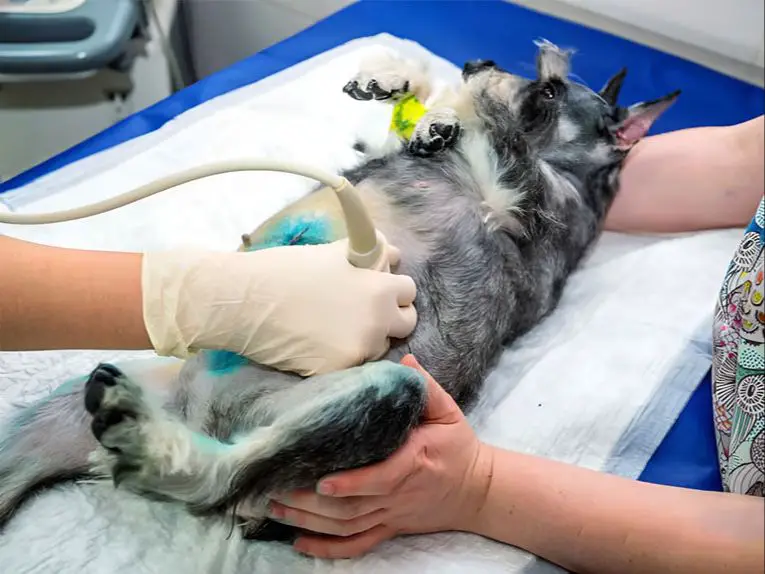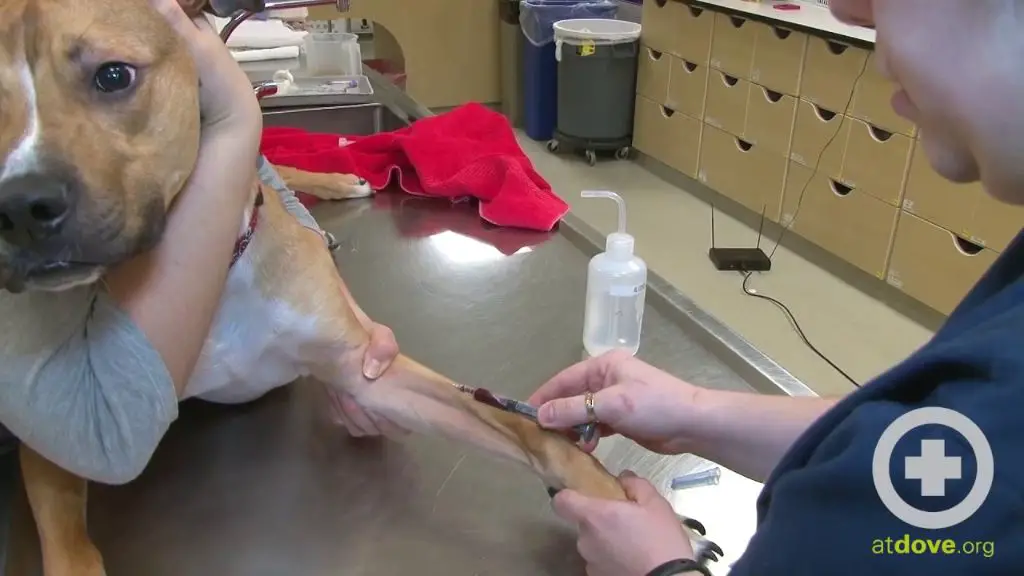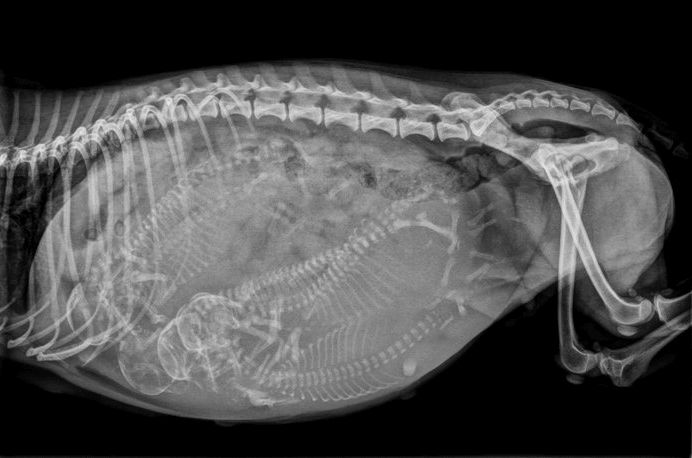Introduction
Confirming dog pregnancy is an important part of prenatal care for breeders and owners. Knowing that a dog is pregnant early allows owners to provide proper nutrition, health care, and prepare whelping areas for the puppies. There are several methods for determining if a dog is pregnant, each offering greater accuracy at different stages of gestation.
Veterinarians can confirm pregnancy in dogs through ultrasound, palpation, hormone tests, or x-rays. Most reliable methods begin at 3-4 weeks after breeding when signs of pregnancy become evident. Having a vet verify pregnancy provides owners peace of mind and allows them to prepare for issues like birthing complications or large litters. Done properly, confirming pregnancy is safe and does not risk the health of puppies. While owners can monitor for symptoms themselves, veterinary exams offer definitive results.
When Can It Be Confirmed
The timing of when a dog’s pregnancy can be confirmed depends on the method used. Here are some of the main options for confirming pregnancy and when they can provide results:
Ultrasound
Ultrasound can detect pregnancy and determine viability of fetuses as early as 3 weeks after breeding. It provides visual confirmation by allowing the vet to see the fetuses developing in the uterus. According to VCA Hospitals, ultrasound is the most accurate way to confirm and monitor pregnancy in dogs (source).

Palpation
Manual palpation of the abdomen can confirm pregnancy starting around day 28-35 by allowing the vet to feel the developing fetuses. According to VCA, palpation diagnosis is about 85% accurate in early pregnancy (source).
Symptoms
A dog’s physical and behavioral changes can indicate pregnancy as early as week 3-4. Symptoms like weight gain, enlarged nipples, nesting behavior, and morning sickness can provide clues before other confirmation methods are possible.
Ultrasound
Ultrasound is one of the most common and accurate ways to confirm dog pregnancy. An ultrasound uses high-frequency sound waves to create images of the puppies and uterus. Ultrasound can detect fetal heartbeats and movement as early as 3-4 weeks into pregnancy. However, the puppies’ skeletal structure is not visible until around day 45.
Ultrasound confirmation is possible as early as day 20-22 after breeding, but can be missed this early. Ultrasound at day 30 post breeding is a great time to confirm pregnancy and determine litter size. The accuracy increases as the pregnancy progresses. By day 45, ultrasound has close to 100% accuracy.
With ultrasound, vets can monitor the health and growth of the puppies throughout pregnancy. It allows them to clearly see the puppies, placentas, and amniotic fluid. This aids in estimating delivery dates and detecting potential issues.
Some limitations are that it requires expensive equipment and expertise. Obese dogs and gas in the abdomen can also limit visibility. But overall ultrasound is a trusted method to confirm and monitor canine pregnancy.
Palpation
Around day 28-30 of the pregnancy, a vet may be able to confirm pregnancy through palpation. This involves gently feeling the abdomen of the pregnant dog to detect fetal movement or position. Experienced vets can detect subtle changes in the dog’s abdomen and the position of the fetuses. The main limitation of palpation is that it can only confirm pregnancy once the fetuses are large enough to be felt, around 4 weeks in.
Palpation allows the vet to get an estimate of litter size by feeling how many fetuses there are. However, palpation is not an exact science and has a margin of error when estimating litter size, especially in the early stages of pregnancy.

Some key things vets look for when palpating a potentially pregnant dog are:
- Enlarged or thickened uterus
- Detecting fetal movement or heartbeats
- Being able to outline the shape, size, and position of fetuses
While an experienced vet can confirm pregnancy through palpation, there are some limitations to be aware of. Palpation may not detect pregnancy until 4-5 weeks along. It also requires skill and experience on the vet’s part, as early changes can be subtle. Palpation alone does not definitively diagnose pregnancy if the vet cannot feel fetuses.
Symptoms
Some of the earliest symptoms of dog pregnancy include changes in appetite, weight gain, nipple changes, and nesting behaviors (Source 1). In the early stages of pregnancy, around 3-4 weeks, a dog’s appetite often decreases due to morning sickness. However, after this initial decrease, a pregnant dog’s appetite will increase significantly. Increased caloric intake helps fuel the growing puppies. You may notice your dog begging for food or eating more at each meal.
Weight gain is another obvious sign of dog pregnancy. A dog’s weight typically increases by 15-25% over the course of the pregnancy as the puppies grow. The weight gain may be gradual at first around weeks 4-5 but will accelerate later on. Make sure to monitor your dog’s weight and adjust her diet accordingly.
Around 4-5 weeks, a pregnant dog’s nipples will “pink up” and become larger and more prominent. This nipple growth prepares the dog for nursing her puppies after birth. You may also notice the nipples secreting a clear fluid towards the end of pregnancy.
As your dog gets closer to delivery, she will start looking for a safe, comfortable place to give birth. This nesting instinct may involve pacing, digging, shredding bedding, or gathering toys. Providing an appropriate whelping box with soft bedding can help satisfy this nesting urge (Source 2).
Blood Tests
Blood tests are one of the most accurate ways to confirm pregnancy in dogs. These tests measure the level of a hormone called relaxin, which is produced by the developing placenta and can be detected in the bloodstream within 20-30 days of conception (Pregnancy Testing in the Dog – VCA Animal Hospitals, THE EASY WAY TO DETECT CANINE/FELINE PREGNANCY).
Relaxin levels rise steadily during pregnancy, making these tests up to 96-98% accurate by 25-30 days after mating (Bellylabs Dog Pregnancy Test). The higher the relaxin level, the further along the pregnancy is. Some blood tests can even estimate gestational age and expected whelping date based on relaxin concentrations.

Blood tests are more reliable than physical exams or symptom monitoring for confirming pregnancy. However, they do require a veterinarian visit to draw blood. At-home blood test kits are not yet available for owners wishing to test their dogs themselves.
X-Rays
One of the most accurate ways to confirm a dog’s pregnancy is through X-rays, usually done after 45 days from the date of breeding. X-rays allow veterinarians to see the puppies’ skeletal structures developing inside the mother. The puppies’ bones begin to calcify around day 45, making them visible on radiographs. If a pregnant dog is X-rayed earlier than this, the skeletons will not show up. X-rays can provide definitive proof of pregnancy by detecting the fetuses, though the number of puppies may be difficult to determine if they are crowded together.
According to Conyers Animal Hospital, X-rays are “probably the most effective way to determine if your dog is pregnant” (source). However, some limitations exist. Positioning the dog properly for X-rays can be difficult depending on the size and cooperation of the animal. The skeletons may overlap on the images, making it challenging to get an accurate puppy count. There are also some safety concerns regarding repeated exposure to radiation that must be weighed against the benefits.
The ideal timing for an X-ray is between days 52-55 of gestation. This allows the skeletons to be clearly visible while minimizing radiation exposure. Some veterinarians may start with an X-ray on day 45 and follow up later in pregnancy to monitor the fetuses. When done at the right time by an experienced veterinary radiologist, X-rays give owners the confidence of knowing their dog is definitively pregnant before she gives birth.

Best Methods
Based on expert vet recommendations, the most accurate ways to confirm dog pregnancy are abdominal ultrasound and blood tests.
An abdominal ultrasound, performed by a veterinarian, can detect pregnancy as early as 3 weeks after breeding and is considered the “gold standard” for confirming pregnancy [1]. Ultrasounds allow vets to visualize the embryos and monitor their development throughout the pregnancy.
Blood tests that measure the hormone relaxin can also reliably detect pregnancy as early as 28 days after breeding [2]. These tests can be performed at the vet’s office or using at-home test kits. At-home kits provide easy, fast, and accurate results.
While symptoms and physical exams like palpation can provide clues, they are less reliable than ultrasound or blood tests for definitively confirming pregnancy in dogs.
After Confirmation
Once pregnancy has been confirmed in your dog, it is important to properly care for her during the pregnancy in order to help ensure the health of both the mother dog and her puppies.
Be sure to feed her a high quality puppy food formulated for pregnant and nursing dogs, as this will provide the extra calories and nutrients she needs. Feed her about 25-50% more than her normal intake. It’s also a good idea to switch her to this diet gradually over 3-4 days to avoid an upset stomach.
Make sure she has constant access to fresh, clean water. Take her out more frequently for bathroom breaks. Limit strenuous exercise, but do take her for daily walks and give some light playtime. This will help keep her fit.
Prepare a quiet and secluded whelping area using a large box or kiddie pool lined with blankets and newspaper. The area should be in a low traffic area of the house and maintain a temperature around 85°F.
Monitor for signs of labor starting, which usually begins around 63 days after breeding. Take her rectal temperature twice daily as her temperature will drop below 100°F within 24 hours of labor starting.
Schedule an appointment with your veterinarian around 4 weeks after breeding to confirm the pregnancy, get an estimated due date, and discuss any special care that may be needed.
Conclusion
To summarize, there are a few main ways a veterinarian can confirm if a dog is pregnant. Ultrasound is often considered the most accurate way to confirm pregnancy early on, usually around 3-4 weeks into gestation. Abdominal palpation by an experienced veterinarian can also confirm pregnancy starting around 4 weeks along. Pregnancy symptoms like appetite changes and nipple enlargement can indicate pregnancy but aren’t definitive. Blood tests and x-rays can also help confirm later in the pregnancy.
While owners may suspect pregnancy based on symptoms, it’s important to have your vet officially confirm it as early as possible. This allows you to properly prepare for whelping and raising a litter. Your vet can advise you on prenatal care, nutrition, and watch for potential complications during pregnancy. They can also accurately determine how far along the pregnancy is and estimate a due date. Regular vet checkups are crucial for monitoring mom and pup’s health during this time. With proper confirmation and care from your veterinarian, you can ensure your pregnant dog has the healthiest pregnancy and delivery possible.